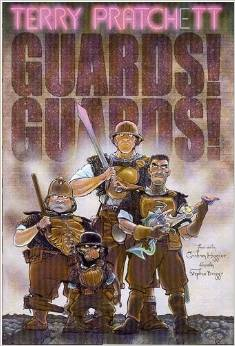What Do the Guards on Your Walls Say About Your City
I've been preparing my first DnD campaign those last weeks and one of the things that passed my mind was how the encounter of the party with the first town would go. While wondering about it the idea of this article grew in my mind. Working on this draft made me think a lot on Prismatic Waystation article about Killable Peoples.
This article is more of a work preparation for the campaign that I thought would be interesting to write down and share at the blog. So when you see me talking about ideas and suggestions that I give you, we can also see as me talking to myself. Anyway let's enter the discussion already.
Much like Killable Peoples teases out what it means when a setting assumes some creatures are “default enemies,” the guards we post around our cities carry unspoken assumptions. They embody who is trusted, who is feared, and who is expendable.
Guards are more than stat blocks with halberds. They are political text, narrative signal, and symbolic declaration. Who stands on those walls, how they are armed, how they treat strangers, these choices all reveal something about the city’s bones, its ruling class, its fears, and its self-image.

Why Guards Matter Beyond Mechanics
At the table, guards are often treated as set dressing. But every choice about them, who they are, where they come from, what rules they follow, tells the players what this society values and fears.
-
If the city employs local militias, it suggests a sense of civic duty and trust.
-
If the walls are manned by mercenaries, it signals internal fragility or the inability to rely on citizens.
-
If the guards are constructs or magical sentinels, that shows both wealth and a deep fear of human corruption.
The very existence of guards implies that someone fears intrusion. But the kind of guards you choose reveals whether that fear is rooted in external threat, internal dissent, or paranoia.
The Guardless Town
What about a settlement with no guards at all? A guardless town says as much, maybe more, than a garrisoned city.
-
Trust in community: The town may rely on strong communal bonds, where everyone is expected to defend everyone else.
-
Isolation or insignificance: Perhaps the town is too small, poor, or remote to warrant a garrison. Who would even bother attacking?
-
Hidden protections: A town without visible guards might instead be defended by unassuming farmers who are deadly with bows, or by quiet deals with nearby bandits, or by a pact with supernatural forces.
-
Naïveté or arrogance: Sometimes a guardless town is simply unprepared or overconfident, and that can be a hook for adventure when danger comes.
A lack of guards is not absence of defense. It’s a story choice. And it tells your players just as much as an army of armored knights.
Axes of Variation: What You Can Change
When designing guards, here are key dimensions to consider. Varying them changes not just the look of the wall, but the politics of the whole city.
| Axis | Variations | What It Implies |
|---|---|---|
| Recruitment and origin | Citizens, conscripts, mercenaries, noble retainers, foreigners, magical beings | Who the city trusts or distrusts. Outsiders suggest fear of locals. Nobles suggest stratification. |
| Status of guards | Prestigious, despised, neutral | If guard duty is honorable, the society valorizes defense. If it’s punishment, the state doesn’t care about who wields force. |
| Rules of engagement | Shoot on sight, demand papers, allow warnings, friendly greeting | Reflects the balance of paranoia, openness, and legitimacy. |
| Technology and tools | Spears, crossbows, firearms, magical wards, golems | Shows the resources and existential threats the city recognizes. |
| Rotation and permanence | Rotating militia shifts, lifelong service, foreign garrisons | Reveals attitudes toward loyalty, corruption, and civic involvement. |
| Uniform and symbolism | Distinct heraldry, faceless masks, simple gear | Symbolism projects authority, fear, or pragmatism. |
| Relationship to populace | Integrated into neighborhoods, stationed apart, policing inside city | Determines whether guards are kin and neighbors or alien occupiers. |
What Different Guards Tell You
Here are some quick reads you can use or remix. You can even use this as a spark table if you want:
-
Citizen militia on the wall → Suggests civic duty, egalitarian trust. Tension: unequal burden, lack of training.
-
Elite knightly guard corps → Martial aristocracy. Tension: guard corps may become a political power of its own.
-
Foreign mercenaries → Regime doesn’t trust its own citizens. Tension: loyalty shifts when gold runs out.
-
Magical constructs → Wealth and fear of human weakness. Tension: who controls the constructs, and what happens if they go rogue?
-
Masked, anonymous guards → Symbol of fear and secrecy. Tension: citizens can’t trust who is behind the mask.
-
Ward-based neighborhood watches → Decentralization. Tension: rivalry between districts, corruption, favoritism.
-
Heavy patrols inside as well as outside → City fears internal rebellion as much as external threat. Tension: authoritarianism, paranoia.
-
Sparse or symbolic guard presence → Either safety or complacency. Tension: vulnerability or hidden menace.
Using Guards Intentionally
It’s easy to default to “a few armored men at the gate.” But if you think of guards as narrative signals, you can make more intentional choices.
Pitfalls to avoid:
-
Don’t assume guards are always loyal and monolithic. Divisions create story.
-
Don’t make them overpowered scene blockers unless that’s the point.
-
Don’t ignore what they imply about society. Mercenaries and militias say different things.
Tips to use them well:
-
Let guard policy changes signal shifts in the city’s politics. A new regiment arrives, or old ones are dismissed.
-
Tie guards to player-facing conflicts: bribery, desertion, recruitment, or guard sympathy for rebels.
-
Use their symbolism, uniforms, rituals, monuments, as ways to convey civic identity without exposition.
-
Make exceptions to rules matter: who gets waved through the gate, and why?
-
Consider what a lack of guards communicates. Sometimes absence is the strongest presence.

A Final Prompt for GMs
When you describe the guards on the walls, or their absence, don’t stop at their armor class. Ask yourself:
-
Who isn’t trusted to stand there?
-
What does the city fear so much it spends its coin on watchers, or what makes it so confident that it doesn’t?
-
Who trains them, who pays them, who replaces them?
Because your players will hear the answers, whether you intend them to or not. And in that way, the guards on your walls are not just guards, they are the city itself, staring back at the world.